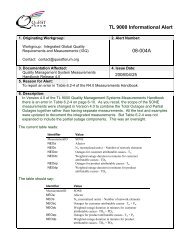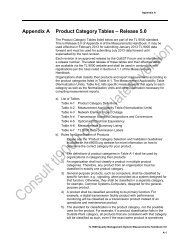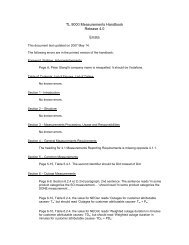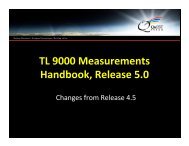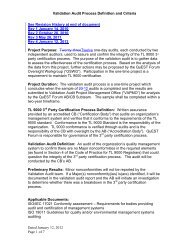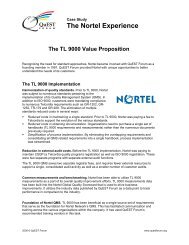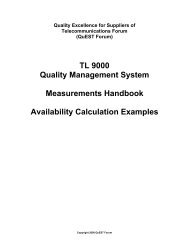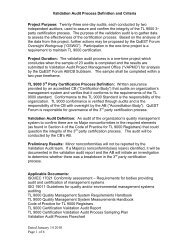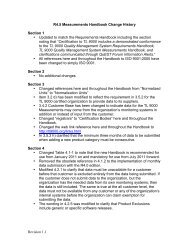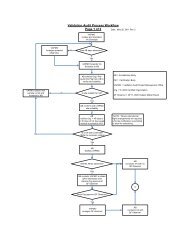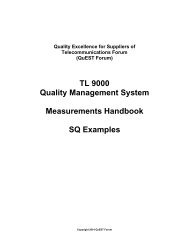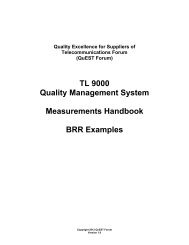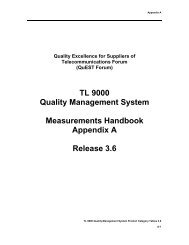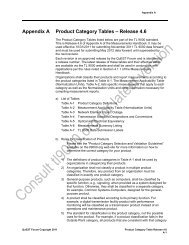10 Steps of Transition - TL 9000
10 Steps of Transition - TL 9000
10 Steps of Transition - TL 9000
Create successful ePaper yourself
Turn your PDF publications into a flip-book with our unique Google optimized e-Paper software.
The 12 <strong>Steps</strong> <strong>of</strong> <strong>Transition</strong><br />
Presented by<br />
Sheronda E. Jeffries<br />
Senior Consultant<br />
SAI Global / Excel Partnership, Inc.<br />
As presented by
2<br />
12 STEPS OF TRANSITION<br />
Gain Knowledge & Commitment<br />
Create a Change Matrix<br />
Create a Plan<br />
Provide or Obtain Training<br />
Review & Update your<br />
Quality Manual<br />
Implement Changes<br />
Conduct Internal Quality Audits &<br />
Management Reviews<br />
Request & Conduct a<br />
Readiness Assessment<br />
Create Action Plans to<br />
Address Nonconformities<br />
Get Upgraded to Release 4.0 <strong>of</strong> the<br />
Requirements Handbook<br />
Get Upgraded to Release 4.0 <strong>of</strong> the<br />
Measurements Handbook<br />
CELEBRATE YOUR TRANSITION!
3<br />
Step 1: Gain Knowledge & Commitment<br />
As the <strong>TL</strong> <strong>9000</strong> <strong>Transition</strong> “Champion”,<br />
you may choose to:<br />
• Review the Handbooks in detail; or<br />
• Participate in e-learning course(s); or<br />
• Attend instructor-led training course (s); or<br />
• All <strong>of</strong> the above!
4<br />
Step 2: Create a Change Matrix<br />
Assess the anticipated scope <strong>of</strong> the work required<br />
to plan and implement the transition to Release<br />
4.0 <strong>of</strong> the Requirements and Measurements<br />
Handbook.
5<br />
Step 2: Create a Change Matrix continued<br />
If your Specialty is Hardware (H) only:<br />
<strong>TL</strong> <strong>9000</strong> Release 4.0 Change <strong>Transition</strong> Delta<br />
5.2.C.2 Customer Communication Methods – The<br />
organization shall establish and maintain methods for<br />
communicating with selected customers to share<br />
expectations, to solicit and consider customer input for<br />
quality planning activities, and to ensure product quality<br />
improvement. The outcome <strong>of</strong> customer<br />
communication should generate actions for resolving<br />
identified issues and provide opportunities for improving<br />
customer satisfaction. [4]<br />
7.2.3.HS.2 Design and Development Process<br />
Quality Measurements Data Reporting – On request<br />
by the customer, communications shall include reporting<br />
and evaluation <strong>of</strong> a jointly agreed set <strong>of</strong> design and<br />
development process measurements.<br />
Changed title. Deleted<br />
‘Procedure(s)’ and added ‘Methods.’<br />
Requirement was reworded to<br />
incorporate intent <strong>of</strong> former bulleted<br />
items into body <strong>of</strong> text. Deleted<br />
procedure requirement.<br />
New Requirement<br />
A documented procedure is<br />
no longer required;<br />
however, verifiable<br />
objective evidence <strong>of</strong><br />
effective implementation is<br />
required.<br />
Will need to review: Set<br />
Up and Operation <strong>of</strong> a<br />
Design Process<br />
Measurement System<br />
(Appendix H)<br />
located at<br />
www.tl<strong>9000</strong>.org/tl_guidance<br />
.htm. Jointly agreed design<br />
process measurements are<br />
to be communicated upon<br />
request by the customer.
6<br />
Step 2: Create a Change Matrix continued<br />
If your Specialty is Service (V) only:<br />
<strong>TL</strong> <strong>9000</strong> Release 4.0 Change <strong>Transition</strong> Delta<br />
5.2.C.2 Customer Communication Methods<br />
– The organization shall establish and maintain<br />
methods for communicating with selected<br />
customers to share expectations, to solicit and<br />
consider customer input for quality planning<br />
activities, and to ensure product quality<br />
improvement. The outcome <strong>of</strong> customer<br />
communication should generate actions for<br />
resolving identified issues and provide<br />
opportunities for improving customer<br />
satisfaction. [4]<br />
Changed title. Deleted<br />
‘Procedure(s)’ and added<br />
‘Methods.’ Requirement was<br />
reworded to incorporate intent <strong>of</strong><br />
former bulleted items into body <strong>of</strong><br />
text. Deleted procedure<br />
requirement.<br />
8.2.4.HV.2 Inspection and Test Records – Reordered. Added bullet e)<br />
Inspection or test records shall include<br />
‘calibrated equipment used (see<br />
a) product identification,<br />
7.6).’ Added reference to 7.6,<br />
b) quantity <strong>of</strong> product,<br />
Control <strong>of</strong> Monitoring and<br />
c) documented procedure(s) followed, Measuring Devices.<br />
d) person performing the test or inspection,<br />
e) calibrated equipment used (see 7.6),<br />
f) date performed, and<br />
g) number, type, and severity <strong>of</strong> defects<br />
found. [5]<br />
A documented procedure is no longer<br />
required; however, verifiable objective<br />
evidence <strong>of</strong> effective implementation is<br />
required.<br />
It is now required to record the<br />
identification <strong>of</strong> any calibrated<br />
equipment being used.
Step 2: Create a Change Matrix continued<br />
If your Specialty is combined Hardware, S<strong>of</strong>tware and Service (HSV):<br />
<strong>TL</strong> <strong>9000</strong> Release 4.0 Change <strong>Transition</strong> Delta<br />
5.2.C.2 Customer Communication Methods – The<br />
organization shall establish and maintain methods for<br />
communicating with selected customers to share expectations,<br />
to solicit and consider customer input for quality planning<br />
activities, and to ensure product quality improvement. The<br />
outcome <strong>of</strong> customer communication should generate actions<br />
for resolving identified issues and provide opportunities for<br />
improving customer satisfaction. [4]<br />
7.2.3.HS.2 Design and Development Process Quality<br />
Measurements Data Reporting – On request by the customer,<br />
communications shall include reporting and evaluation <strong>of</strong> a<br />
jointly agreed set <strong>of</strong> design and development process<br />
measurements.<br />
Changed title. Deleted<br />
‘Procedure(s)’ and<br />
added ‘Methods.’<br />
Requirement was<br />
reworded to incorporate<br />
intent <strong>of</strong> former bulleted<br />
items into body <strong>of</strong> text.<br />
Deleted procedure<br />
requirement.<br />
New Requirement<br />
8.2.4.HV.2 Inspection and Test Records – Inspection or test Reordered. Added<br />
records shall include<br />
bullet e) ‘calibrated<br />
a) product identification,<br />
equipment used (see<br />
b) quantity <strong>of</strong> product,<br />
7.6).’ Added reference<br />
c) documented procedure(s) followed,<br />
to 7.6, Control <strong>of</strong><br />
d) person performing the test or inspection,<br />
Monitoring and<br />
e) calibrated equipment used (see 7.6),<br />
Measuring Devices.<br />
f) date performed, and<br />
g) number, type, and severity <strong>of</strong> defects found. [5]<br />
“<strong>TL</strong> <strong>9000</strong> Measurements” 3.5.2e<br />
Changed requirement<br />
from quarterly<br />
submissions to monthly<br />
submissions.<br />
A documented procedure is<br />
no longer required; however,<br />
verifiable objective evidence<br />
<strong>of</strong> effective implementation is<br />
required.<br />
Will need to review: Set Up and<br />
Operation <strong>of</strong> a Design Process<br />
Measurement System<br />
(Appendix H)<br />
located at<br />
www.tl<strong>9000</strong>.org/tl_guidance.htm.<br />
Jointly agreed design process<br />
measurements are to be communicated<br />
upon request by the customer.<br />
It is now required to record<br />
the identification <strong>of</strong> any<br />
calibrated equipment being<br />
used.<br />
This requirement must be<br />
implemented for the 01/2008<br />
submittal.
8<br />
Step 3: Create a Plan<br />
Clause 5.4.2 b requires<br />
top management ensure<br />
that the integrity <strong>of</strong> the<br />
quality system is maintained<br />
when changes are planned<br />
and implemented.<br />
Successful <strong>TL</strong> <strong>9000</strong> Release 4.0/4.0<br />
transition relies on a strong commitment<br />
from leaders throughout the organization.
9<br />
Step 3: Create a Plan continued<br />
• Allocate Resources<br />
Initiate a method to monitor costs versus budget<br />
• Assign tasks, responsibilities, and due dates<br />
-Add columns to the Change Matrix or use any<br />
Project Management tool/s<strong>of</strong>tware for monitoring<br />
and tracking<br />
• Involve Process Owners / Customers / Suppliers
<strong>10</strong><br />
Step 3: Create a Plan continued<br />
Consider:<br />
• “Lessons Learned” from initial <strong>TL</strong> <strong>9000</strong> Registration<br />
implementation<br />
• Quality Management System performance since initial<br />
<strong>TL</strong> <strong>9000</strong> Registration<br />
• Focus upon the corporate strategy along with the<br />
issues <strong>of</strong> top management and customers<br />
This is an opportunity to make significant,<br />
meaningful changes to work processes<br />
and to how the organization operates!
11<br />
<strong>Transition</strong> Timeline<br />
<strong>Transition</strong> to Release 4.0 <strong>of</strong> the Requirements Handbook should occur prior to July 1, 2007.<br />
<strong>Transition</strong> to Release 4.0 <strong>of</strong> the Measurements Handbook should occur prior to July 1, 2007.<br />
Create a<br />
Change<br />
Matrix<br />
Identify &<br />
Assign<br />
<strong>Transition</strong><br />
Champion<br />
Identify &<br />
Assign<br />
<strong>Transition</strong><br />
Team Members<br />
Provide or Obtain<br />
Training<br />
Update the<br />
Quality<br />
Manual<br />
General<br />
Associate<br />
Training<br />
Initiate Release. 4.0<br />
Internal Quality Audits &<br />
Management Reviews<br />
Request a GAP<br />
Assessment<br />
Celebrate the<br />
<strong>Transition</strong>!<br />
Upgrade to<br />
Release 4.0<br />
Measurements<br />
Create a<br />
<strong>Transition</strong><br />
Plan<br />
Implement<br />
Changes<br />
Create Action Plans<br />
to address<br />
Nonconformities &<br />
Implement Actions<br />
Most organizations plan on<br />
upgrading to 4.0/4.0!<br />
Upgrade to<br />
Release 4.0<br />
Requirements
12<br />
Key <strong>Transition</strong> Timeline Dates<br />
• All Registrar audits, whether surveillance or initial Registration, must use<br />
Release 4.0 <strong>of</strong> the Requirements Handbook after July 1, 2007.<br />
• Release 4.0 <strong>of</strong> the Measurement Handbook was effective December 31, 2006<br />
and must be used to submit data dated July 2007 forward. Release 4.0 <strong>of</strong> the<br />
Measurement Handbook may be used for data dated January 2007 through<br />
June 2007, although organizations are encouraged to use the release for the<br />
data submission following the availability <strong>of</strong> the new handbook. For the change<br />
from quarterly data submittal to monthly data submittal, this change does<br />
not have to implemented until the submittal <strong>of</strong> data for January 2008.<br />
• The minimum number <strong>of</strong> data submittals needed to move to a new release <strong>of</strong> the<br />
Measurement Handbook is one. With the move to monthly data submittals in<br />
R4.0, this data submittal could be for a single month <strong>of</strong> data.<br />
• For additional information on data submittals please see Section 4.1.1 <strong>of</strong><br />
Release 4.0 <strong>of</strong> the Measurement Handbook and <strong>TL</strong> <strong>9000</strong> Informational Alert<br />
#06-004A.
13<br />
Step 4: Provide or Obtain Training<br />
• <strong>Transition</strong> Team<br />
• Process Owners<br />
• Management Team<br />
• Internal Quality Auditors<br />
• Measurements Team including IT / MIS
14<br />
Step 5: Review & Update your Quality Manual<br />
• Although there are now 90 adders, there may be<br />
some that are not applicable to your organization. A<br />
simple “NA” may address the adder.<br />
• Consider renumbering your documents and/or reformatting<br />
your documents to make them more “userfriendly”.<br />
• Require process owners review their processes,<br />
documents, and templates for compliance and<br />
improvement.
15<br />
Step 6: Implement Changes<br />
Release 4.0 <strong>of</strong> the <strong>TL</strong> <strong>9000</strong> Requirements Handbook<br />
contains a number <strong>of</strong> significant changes.<br />
The definition <strong>of</strong> a “Method” as shown in the Glossary<br />
has been revised:<br />
Method – A means by which an activity is accomplished<br />
which is not necessarily documented but which is<br />
demonstrated to be consistent and effective throughout the<br />
organization. Effective implementation <strong>of</strong> a method is<br />
demonstrated by the existence <strong>of</strong> verifiable objective<br />
evidence (e.g., observation or record).
16<br />
Step 6: Implement Changes continued<br />
12 significant changes to <strong>TL</strong> <strong>9000</strong> Requirements Handbook, Rel. 4.0<br />
5.4.2.C.1<br />
6.2.2.C.2<br />
6.3.C.1<br />
7.1.C.4<br />
7.2.2.C.2<br />
7.2.3.HS.2<br />
7.3.1.HS.1<br />
7.3.1.HS.2<br />
7.3.5.HS.1<br />
7.3.5.HS.2<br />
7.6.C.1<br />
8.2.3.C.1<br />
Long- and Short-Term Quality Planning<br />
Quality and Process Improvement Concepts<br />
Infrastructure<br />
Tools Management<br />
Contract Review<br />
Design and Development Process Quality Measurements Data Reporting<br />
Migration Planning<br />
Design and Development Process Quality Measurements Planning and Implementation<br />
Stress Testing<br />
Abnormal Conditions<br />
Equipment Identification<br />
Process Measurement<br />
= New <strong>TL</strong> <strong>9000</strong><br />
Adder
17<br />
Step 6: Implement Changes continued<br />
Set Up and Operation <strong>of</strong> a Design Process<br />
Measurement System (Appendix H)<br />
Effective June 30, 2006<br />
• Provides guidance on the selection and<br />
implementation <strong>of</strong> design process measurements<br />
• May apply to projects and processes<br />
• Supports 7.2.3.HS.2, 7.3.1.HS.2 and 8.2.3.C.1<br />
• Located at<br />
www.tl<strong>9000</strong>.org/tl_guidance.htm
18<br />
Step 6: Implement Changes continued<br />
Significant Changes to Release 4.0 <strong>of</strong> the <strong>TL</strong> <strong>9000</strong><br />
Measurements Handbook include:<br />
Organizations shall:<br />
3.5.2 e) submit monthly date every calendar month after becoming registered no later than<br />
seven weeks after the end <strong>of</strong> the month<br />
3.5.2 k) have the option <strong>of</strong> re-submitting data using the current tools, requirements <strong>of</strong> the<br />
current handbook, and current effective product category tables or using the tools,<br />
requirements, and product category tables in effect at the time data was originally<br />
submitted<br />
and<br />
3.5.2 l) provide their suppliers all necessary data to allow the supplier to generate their <strong>TL</strong><br />
<strong>9000</strong> measurements
19<br />
Step 6: Implement Changes continued<br />
Other significant changes for organizations<br />
currently registered to Rel. 3.5 <strong>of</strong> the <strong>TL</strong> <strong>9000</strong><br />
Measurements Handbook include:<br />
• Late Data Submission Alert 06-003A<br />
• FRT threshold times can be modified based upon SLAs for all<br />
PCTs except 7 & 8<br />
• Simplified S<strong>of</strong>tware measurements which are no longer based<br />
upon the s<strong>of</strong>tware architecture + Creation <strong>of</strong> new S<strong>of</strong>tware<br />
measurements<br />
• Changes to the Service measurements
20<br />
Step 6: Implement Changes continued<br />
For most <strong>TL</strong> <strong>9000</strong> registered organizations, Release 4.0 <strong>of</strong><br />
the <strong>TL</strong> <strong>9000</strong> Measurements Handbook provides an<br />
opportunity to assure better alignment <strong>of</strong> process<br />
measurements, including design and development process<br />
measurements, with product measurements,<br />
management’s objectives, and customer expectations.<br />
% On time Delivery<br />
to Customer<br />
M1<br />
M2<br />
M2<br />
M2<br />
M2<br />
On schedule<br />
On schedule<br />
On schedule<br />
Shipped<br />
M3<br />
M3<br />
on time<br />
% Low stock<br />
% Rework<br />
Design/Dev.<br />
Mfg<br />
Shipping<br />
Purch.
21<br />
Step 7: Conduct Internal Quality Audits &<br />
Management Reviews<br />
The Internal Audit Schedule and/or internal audit records should<br />
clearly denote which audits were conducted against Release 4.0/4.0<br />
“Utilize <strong>TL</strong> <strong>9000</strong><br />
measurements for<br />
continual improvement<br />
and management review.”<br />
Management<br />
Review<br />
“Measure<br />
performance against<br />
defined, measurable<br />
objectives.”<br />
Corrective &<br />
Preventive<br />
Action<br />
Continual<br />
Improvement<br />
Internal Audit
22<br />
Step 8:<br />
Request/Conduct a Readiness Assessment<br />
• Request a Readiness Assessment from a sister<br />
organization; from your Registrar; or from an outside<br />
Consulting/Training organization.<br />
• Readiness Assessments conducted by your Registrar<br />
could occur during your regularly scheduled<br />
surveillance assessments depending upon your<br />
surveillance assessment timing.<br />
• Most Registrars have been discussing Release 4.0/4.0<br />
<strong>of</strong> the <strong>TL</strong> <strong>9000</strong> Handbooks during their <strong>TL</strong> <strong>9000</strong><br />
surveillance audits.
23<br />
Step 9: Create Action Plans to Address<br />
Nonconformities<br />
8.2 8.4 8.5<br />
Monitoring<br />
&<br />
Measurement<br />
Analysis<br />
<strong>of</strong> Data<br />
Improvement<br />
Management<br />
Review<br />
5.6<br />
Successful <strong>TL</strong> <strong>9000</strong> Release 4.0/4.0 transition relies on a strong commitment<br />
from leaders throughout the organization.
24<br />
Step <strong>10</strong>: Upgrade to Release 4.0 <strong>of</strong> the<br />
Requirements Handbook<br />
<strong>TL</strong> <strong>9000</strong> Release 4.0<br />
Requirements Registered
25<br />
Step 11: Upgrade to Release 4.0 <strong>of</strong> the<br />
Measurements Handbook<br />
<strong>TL</strong> <strong>9000</strong> Release 4.0<br />
Measurement Registered
26<br />
Step 11.5: Upgrade to Release 4.0/4.0 <strong>of</strong> <strong>TL</strong> <strong>9000</strong><br />
All audits conducted after<br />
July 1, 2007 must be<br />
performed to R4.0/4.0 <strong>of</strong><br />
the <strong>TL</strong> <strong>9000</strong> Handbooks.
27<br />
Step 12: CELEBRATE YOUR<br />
TRANSITION!<br />
• Communicate to internal<br />
personnel through meetings,<br />
flyers, newsletters, etc.<br />
• Promote your <strong>TL</strong> <strong>9000</strong><br />
4.0/4.0 Registration to your<br />
customers and suppliers.<br />
• Reward the <strong>Transition</strong> Team<br />
and all personnel involved.
28<br />
Summary<br />
For assistance in creating and implementing a <strong>TL</strong> <strong>9000</strong> Release<br />
4.0/4.0 <strong>Transition</strong> Plan specific to your organization, please<br />
contact any QuEST Forum Approved Training Provider<br />
For information regarding <strong>TL</strong> <strong>9000</strong> Release 4.0/4.0 , please visit:<br />
www.tl<strong>9000</strong>.org then the handbooks menu item.<br />
Sheronda E. Jeffries, SAI/Excel Partnership, Inc.<br />
(919) 544-9324 Home Office; (919) 641-0608 Cell or sjeffrie@xlp.com<br />
Thank You!



